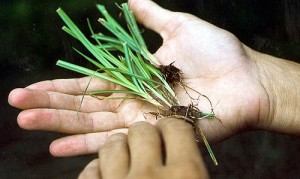Yellow nutsedge is a grass-like perennial plant that thrives in lawns and areas of turf, which are usually exposed to excessive moisture. Being a perennial plant, meaning that it grows for more than two years due to subterranean roots (tubers) that survive through winter months and sprout the following spring, makes this weed difficult to control. It has made its way into the yards of homes and commercial properties by various ways. It could have been that new sod you had put down last year, or in the dirt you used to put down grass seed, or even in the bag of grass seed itself. What about the mulch you used to top-dress your planter beds or around your trees? There is no way to tell exactly how or why it has appeared, but if you are reading this, you have probably got some nutsedge lingering in your yard somewhere.
If you are having a hard time identifying yellow nutsedge, it looks like a thicker kind of turf grass that tends to grow at twice the rate of normal turf. It is lighter green in color, making it look yellow compared to the rest of the turf area. With triangular shaped solitary stems, the foliage is thicker, wider, tough and waxy. Once you identify it, nutsedge will stick out like a sore thumb.

Nutsedge can ruin your nicely manicured lawn!
Controlling yellow nutsedge can be very difficult. Simply mowing the plant along with the rest of the grass does absolutely nothing to it, and can often assist in spreading the weed, should any seeds be displaced. If left untreated, yellow nutsedge spreads via rhizomes, which are subterranean stems that produce shoots at different points, and can multiply very quickly.
The best-known defense to yellow nutsedge is your bare hands. That’s right, by simply pulling it! But that could take hours, and for some, days. Who wants to spend hours or days roaming their yard, manually pulling a weed, only for more to show up the next week? Cultivation may be effective if done on a regular basis, but again, who wants to grind up their yard, or spots in their yard, every year, leaving the only option to re-seed or sod?

Don’t let this perennial weed take over.
Through performing good cultural practices, (mowing, watering, fertilizing, aerating), and with the assistance of a quality selective herbicide, this weed can be controlled. Selective herbicides are just that; selective. They select the weed or plant that they are going to control, leaving the turf and surrounding area virtually unharmed. Once applied, the herbicide is absorbed through the foliage of the plant and then trans-located to the root system, killing it. More than one application may be necessary for complete control.
Contact Barrett specialists today for advice!


